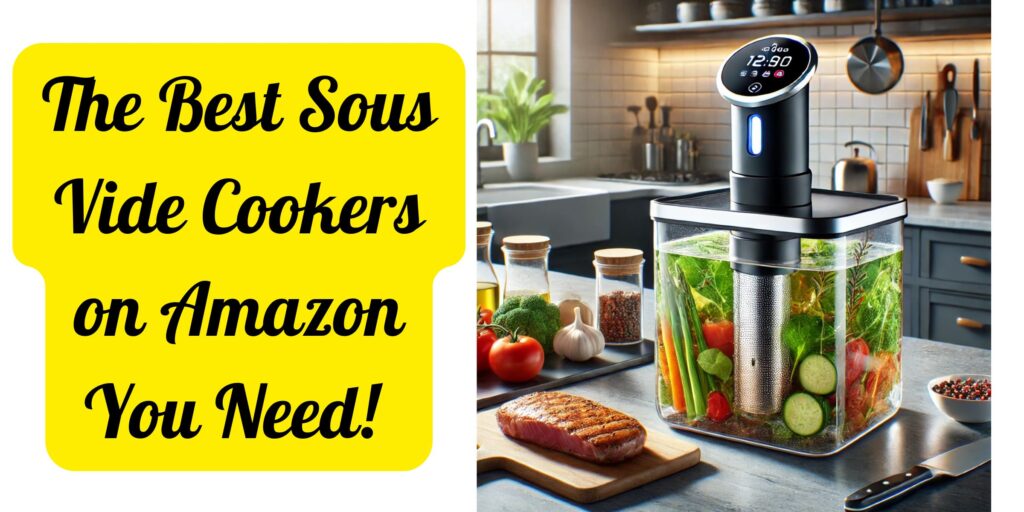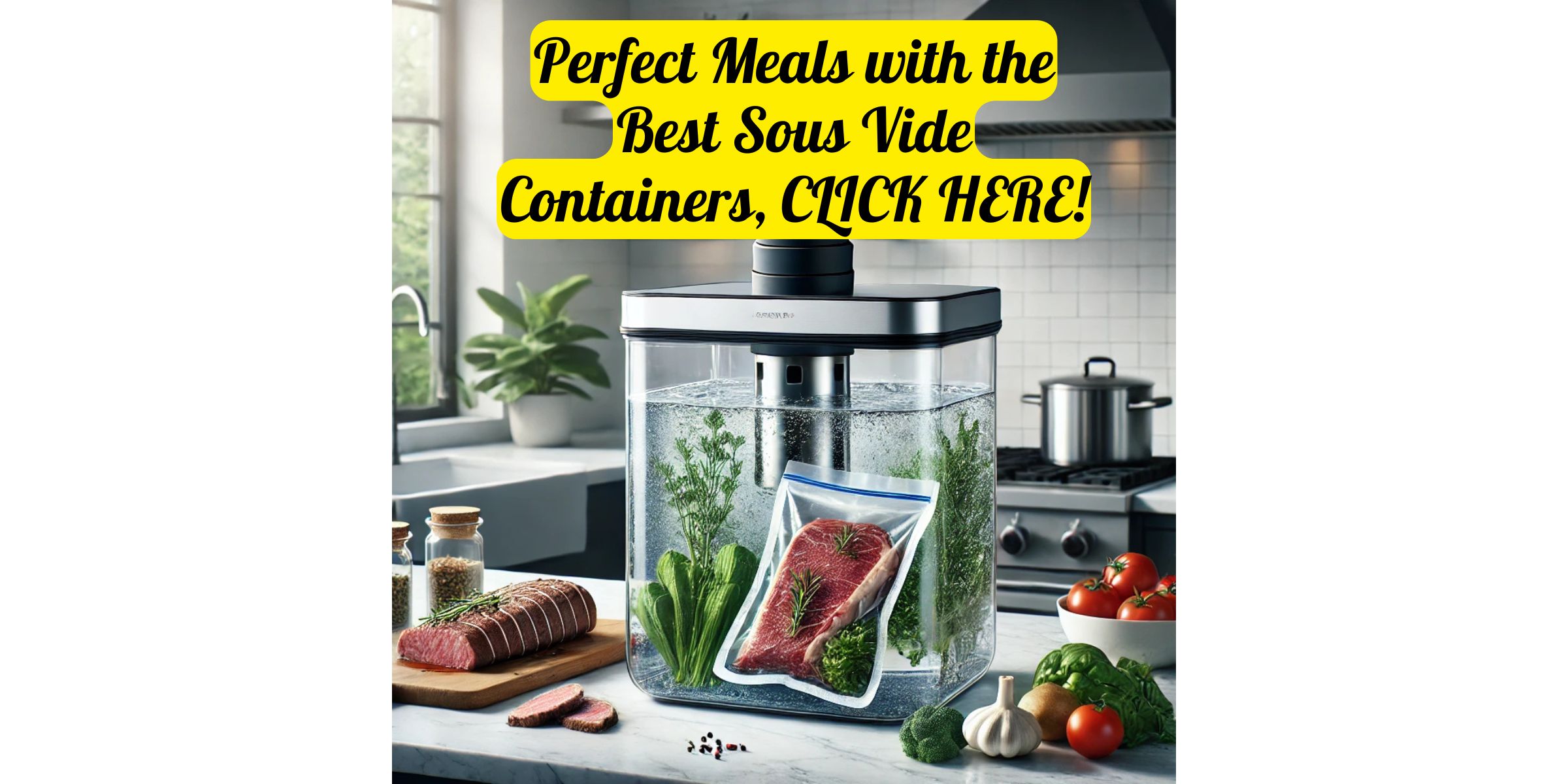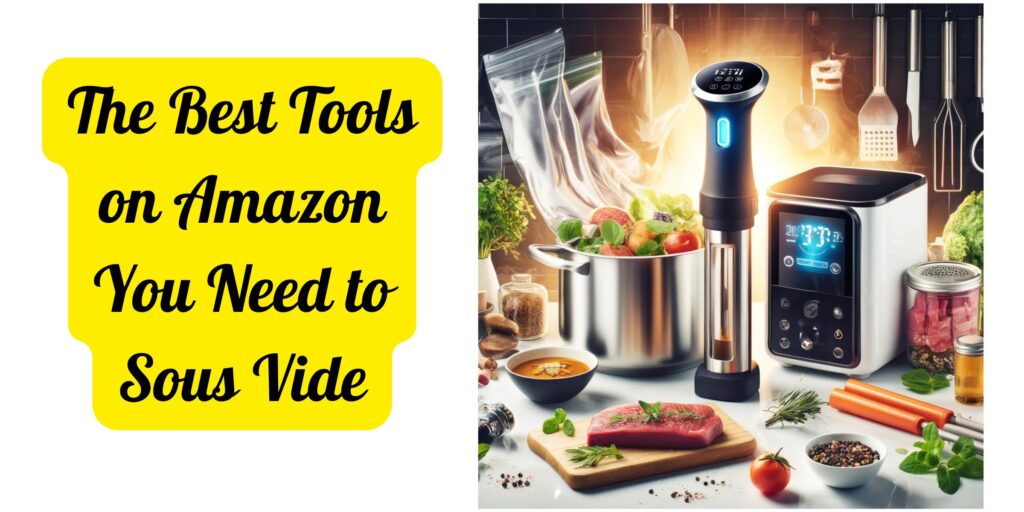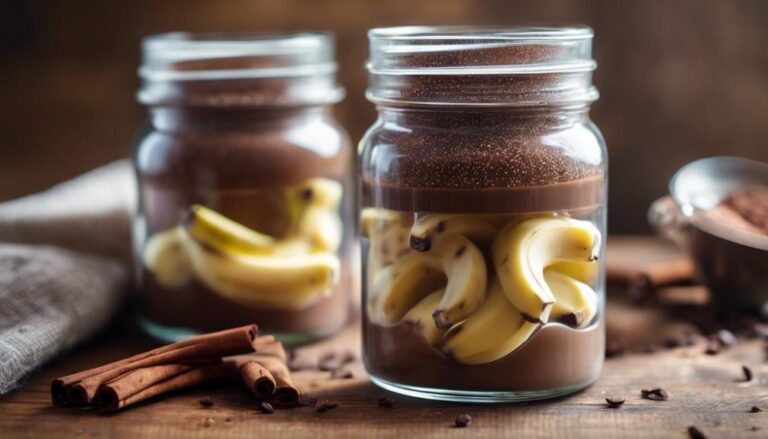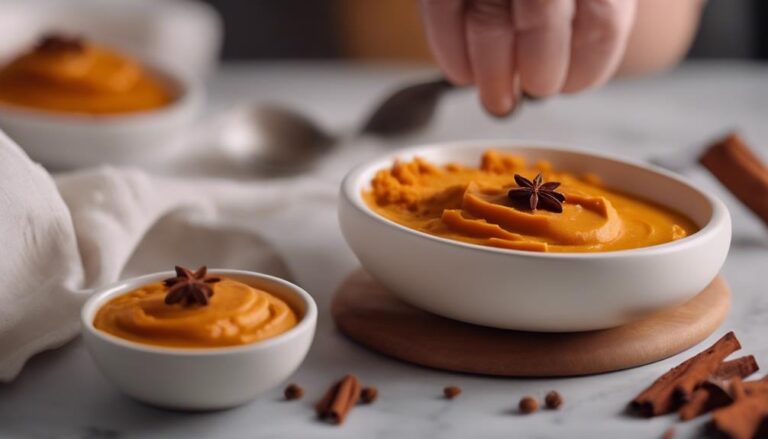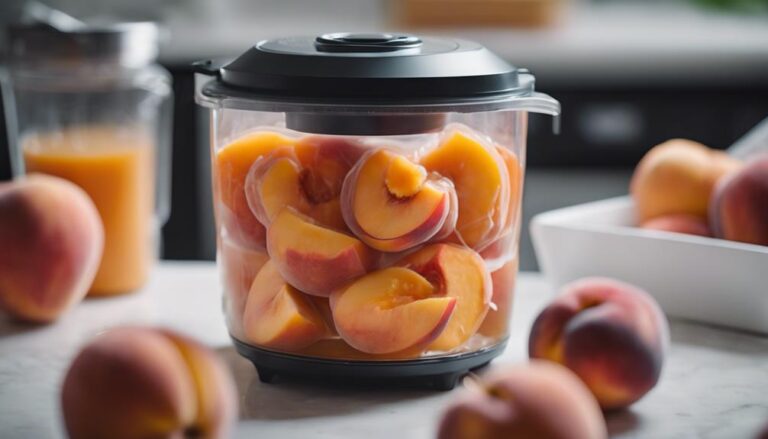Sous Vide Chicken and Sweet Corn Purees for a Baby Food Diet Lunch
Create nutritious sous vide chicken and sweet corn purees for a baby food lunch. Seal the seasoned chicken breast and sweet corn in bags, then cook them in a water bath for juicy tenderness. Safety tip: guarantee the chicken reaches the recommended internal temperature. Blend the cooked ingredients into smooth purees for easy digestion. The sous vide method locks in flavors and nutrients, ideal for introducing diverse tastes to your baby's diet. Enhance your baby's meals with these wholesome purees, promoting healthy development and a love for delicious food. Get ready to tantalize your baby's taste buds with these homemade delights!
What You Will Learn Here
- Sous Vide cooking ensures safe and precise preparation of chicken and sweet corn purees for baby-led weaning.
- Chicken cooked sous vide retains moisture and tenderness, ideal for baby food diets.
- Sweet Corn Puree, rich in fiber and vitamins, complements the chicken for a balanced baby meal.
- Homemade purees offer fresh, preservative-free nutrients essential for a baby's growth and development.
- Texture modifications in sous vide cooking create easy-to-eat and nutritious options for babies.
Origins of Sous Vide

Sous Vide is a cooking technique that involves vacuum-sealing food in a bag and cooking it in a precisely controlled water bath. It has its origins in the 18th century. This culinary innovation has gained popularity in recent years due to its ability to deliver consistent and perfectly cooked results.
Sous Vide is known for its precision cooking methods, ensuring that food is cooked evenly and retains its flavors and nutrients.
Sous Vide Technique
Originally developed in France in the 1970s, the sous vide technique revolutionized the culinary world by introducing a precise method of cooking food at controlled temperatures in vacuum-sealed bags.
Sous vide benefits include retaining the natural flavors and nutrients of the ingredients, resulting in tender and juicy meats, perfectly cooked vegetables, and consistent textures.
To utilize the sous vide technique, you'll need specific equipment such as a sous vide immersion circulator and vacuum sealer.
The immersion circulator maintains a constant water temperature for precise cooking, while the vacuum sealer guarantees airtight packaging to cook the food evenly without losing moisture or flavors.
Culinary Innovation
The origins of the sous vide technique can be traced back to the innovative efforts of French chefs in the 1970s, transforming traditional cooking methods with a focus on precision and flavor retention.
By sealing ingredients in airtight bags and cooking them in a water bath at precise temperatures, chefs discovered a way to enhance the natural tastes of foods while preserving their textures.
This culinary innovation paved the way for a new domain of cooking possibilities, allowing for the infusion of innovative flavors into dishes through the use of modern techniques.
Through sous vide cooking, chefs can achieve consistent results and experiment with combinations of ingredients that mightn't have been possible with traditional methods.
The controlled cooking environment guarantees that flavors are intensified and ingredients are cooked evenly, resulting in dishes that aren't only delicious but also visually appealing.
The marriage of innovative flavors and modern techniques in sous vide cooking has revolutionized the culinary world, offering chefs a way to push the boundaries of traditional cooking and elevate the dining experience for food enthusiasts worldwide.
Precision Cooking Methods
One pivotal moment in culinary history marked the beginning of precision cooking methods, introducing a technique that revolutionized traditional approaches with a focus on accuracy and flavor enhancement. Sous vide, meaning 'under vacuum' in French, has become a prominent method in modern culinary trends due to its numerous benefits.
This technique involves vacuum-sealing food in a bag and cooking it at precise temperatures in a water bath. The controlled environment guarantees that the food retains its moisture, tenderness, and flavor, making it a popular choice among chefs and home cooks alike.
To start on your sous vide journey, you'll need specific equipment such as a sous vide machine or immersion circulator to regulate the water temperature. Cooking tips include properly sealing the food in a bag to prevent air exposure, ensuring even cooking.
With sous vide, you can experiment with various ingredients and recipes, discovering a world of culinary possibilities with perfectly cooked dishes every time.
Key Ingredients for Sous Vide
When preparing sous vide dishes, selecting fresh and high-quality ingredients is essential for the best flavor and texture.
Here are four key ingredients to contemplate for your sous vide cooking:
- Proteins: Opt for fresh proteins like chicken, beef, or fish for sous vide cooking. The sous vide benefits include flavor retention and enhanced tenderness due to the precise cooking temperatures.
- Seasonings and Herbs: High-quality seasonings and herbs can elevate the flavors of your sous vide dishes. Make sure to use fresh herbs and aromatic seasonings to enhance the taste profile.
- Vegetables: Fresh vegetables like sweet corn, carrots, and asparagus can complement your sous vide dishes. Vacuum sealing these vegetables with seasonings before cooking can intensify their natural flavors.
- Broths and Marinades: Using flavorful broths or marinades in your vacuum-sealed bags can infuse the ingredients with additional taste during the sous vide process. Experiment with different combinations to create delicious meals.
Sous Vide Chicken Breast Recipe

When preparing a sous vide chicken breast recipe, you'll want to make sure the chicken is seasoned well before vacuum-sealing it for cooking.
Once the chicken is cooked to perfection in the sous vide bath, you can pair it with a delicious sweet corn puree and a side of mashed carrots for a well-rounded meal.
These three components come together to create a nutritious and flavorful dish that's perfect for a baby food diet lunch.
Chicken Breast Sous Vide Recipe
For a perfectly cooked chicken breast, sous vide is a foolproof method that guarantees juicy and tender results. Here's how to achieve a delicious sous vide chicken breast:
- Chicken Tenderness and Cooking Time
To guarantee tender chicken, set your sous vide machine to 140°F (60°C) for 1-4 hours, depending on the thickness of the breast. This gentle cooking method preserves the natural juices, resulting in a moist and succulent texture.
- Flavor Infusion and Seasoning Options
Before sealing the chicken in a vacuum-sealed bag, season it generously with your favorite herbs and spices. This step allows the flavors to infuse into the meat during the sous vide process. Popular seasoning options include garlic, thyme, rosemary, paprika, and lemon zest.
- Sous Vide Cooking
Once seasoned, place the chicken breast in the preheated water bath and let it cook slowly and evenly. The precise temperature control of sous vide cooking assures that the chicken reaches the perfect doneness without any risk of overcooking.
- Finishing Touch
After sous vide cooking, sear the chicken briefly in a hot skillet or grill to develop a golden-brown crust for added flavor and texture.
Enjoy your perfectly cooked sous vide chicken breast!
Sweet Corn Puree Recipe
To achieve a creamy and flavorful sweet corn puree that complements your sous vide chicken breast, consider incorporating fresh corn kernels and a hint of butter for richness. Here are some tips to enhance your sweet corn puree:
- Corn Puree Variations:
Experiment with different herbs like thyme or basil to add a unique twist to your corn puree. You can also mix in a splash of coconut milk for a tropical flavor profile.
- Baby Led Weaning:
Sweet corn puree is a great option for baby-led weaning due to its smooth texture and mild taste. Make sure the puree is of a suitable consistency for your baby's developmental stage.
- Nutritional Benefits:
Sweet corn is rich in fiber, vitamins, and antioxidants, making it a nutritious addition to your baby's diet. It promotes healthy digestion and supports overall growth and development.
- Texture Modifications:
Adjust the texture of the corn puree by adding a bit of vegetable broth or milk to achieve your desired consistency. This allows you to cater to different preferences, from smooth to slightly chunky, for a versatile dish.
Mashed Carrot Side Dish
Enhance your sous vide chicken breast with a delightful side of mashed carrots that adds a vibrant color and sweet flavor to your baby food diet lunch. Mashed carrots are a perfect accompaniment to the tender chicken, providing a nutritious and visually appealing addition to your meal.
Here are some reasons why you should consider adding mashed carrots to your baby's diet:
- Baby led weaning: Mashed carrots are a great option for introducing solid foods to your baby, promoting self-feeding and developing their motor skills.
- Homemade baby food: Making your own carrot puree guarantees that your baby is consuming fresh, preservative-free food packed with essential nutrients.
- Nutrient-rich: Carrots are rich in beta-carotene, which is converted into vitamin A in the body, essential for your baby's growth and development.
- Sweet flavor: The natural sweetness of carrots appeals to babies' taste buds, making it a popular choice for homemade baby food recipes.
Sous Vide Temperature Recommendations
When cooking sous vide, it's important to take into account ideal temperatures for different types of food. Safe cooking temperatures guarantee that your meals aren't only delicious but also free from harmful bacteria.
Following precision cooking guidelines will help you achieve perfect results every time.
Optimal Sous Vide Temperatures
For precise cooking results when using sous vide, maintaining the ideal temperatures recommended for each type of food is essential. Sous vide equipment, known for its precise temperature control, offers many benefits, including the ability to cook food evenly and retain its natural flavors.
When it comes to sous vide safety, guaranteeing that food reaches the right temperature is vital to prevent harmful bacteria growth while preserving the delicate taste profiles of ingredients.
Different foods require specific sous vide temperatures to achieve the best results. For example, poultry like chicken should be cooked at around 140°F (60°C) to ensure it's safe to eat while remaining tender and juicy.
On the other hand, vegetables such as sweet corn might benefit from a lower temperature around 183°F (84°C) to maintain their vibrant color and nutrients.
Safe Cooking Temperatures
To guarantee the safety and quality of your sous vide cooking, it's essential to follow specific temperature recommendations for different types of food. Food safety is paramount when it comes to cooking, especially in sous vide methods.
The cooking temperature guidelines for sous vide vary depending on the type of food you're preparing. For poultry like chicken, it's important to cook it at a temperature of at least 165°F (73.9°C) to make sure that harmful bacteria are eliminated.
Similarly, for beef, the recommended temperature is around 130°F (54.4°C) for a medium-rare doneness.
Following these temperature guidelines not only ensures that your food is safe to eat but also helps in retaining its flavors and nutrients.
It's important to use a reliable sous vide machine with precise temperature control to achieve the desired results. By adhering to these cooking temperatures, you can enjoy delicious and safely prepared meals for you and your family.
Precision Cooking Guidelines
Guarantee precise cooking by adhering to specific temperature recommendations when utilizing sous vide techniques for various types of food. For food safety, it's important to cook poultry like chicken at 140°F (60°C) for a minimum of 90 minutes to make sure harmful bacteria are eliminated.
Fish should be cooked at 122°F (50°C) for at least 40 minutes for safe consumption. When preparing beef, a temperature of 131°F (55°C) for 5 hours is recommended to achieve the desired tenderness while maintaining food safety standards.
Apart from food safety, precise cooking temperatures play a significant role in flavor development. Cooking vegetables at lower temperatures, around 183°F (84°C), helps retain their natural flavors and nutrients, enhancing the overall taste of the dish. This method also preserves the texture of the ingredients, ensuring a satisfying dining experience.
Final Thoughts

Consider incorporating a variety of flavors and textures to keep your baby engaged during mealtime. While the Sous Vide Chicken and Sweet Corn Purees offer excellent baby food alternatives, it's crucial to explore other nutritious lunch options to guarantee your baby receives a well-rounded diet.
Introducing different fruits, vegetables, meats, and grains can provide diverse nutrients and help develop your baby's palate.
When planning your baby's meals, aim for a balance of proteins, carbohydrates, and healthy fats. Experimenting with homemade purees, mashes, and small soft pieces can offer sensory experiences that support your baby's development.
Remember to consult with your pediatrician about any dietary concerns or food allergies your baby may have.
Frequently Asked Questions
Can I Use Frozen Chicken for Sous Vide Cooking?
Yes, you can use frozen chicken for sous vide cooking. Make sure it's completely thawed before starting. Sous vide techniques require precise temperature control for food safety. Follow recommended cooking times to achieve safe and delicious results.
How Long Can I Store Homemade Baby Food Purees?
You can store homemade baby food purees in the fridge for around 3 days and in the freezer for up to 3 months. Remember to check for any signs of spoilage and follow proper storage guidelines to guarantee safety.
Is It Safe to Sous Vide Cook for a Baby?
It's important to take into account your baby's digestion and safety concerns when sous vide cooking for them. Make sure nutritional benefits meet their developmental stages. Always prioritize your little one's well-being when preparing meals.
Can I Add Seasonings to the Baby Food Purees?
Yes, you can add seasonings to baby food purees. When it comes to flavoring options for infants, opt for mild spices. Cinnamon, nutmeg, or a pinch of mild herbs can enhance the taste without overwhelming their palate.
Can I Use a Regular Ziplock Bag for Sous Vide Cooking?
Yes, you can use a regular ziplock bag for Sous Vide cooking. However, make sure it's food-grade and can withstand the cooking temperature. Prioritize food safety to prevent any risks. Always research the bag's suitability for this cooking method.
Conclusion
To sum up, sous vide cooking offers a precise and reliable method for preparing tender and flavorful chicken. By following the recommended temperatures and utilizing quality ingredients, you can create a delicious and nutritious meal for your baby.
Experimenting with different flavors and textures, such as sweet corn purees, adds variety to their diet while ensuring they receive the essential nutrients they need.
Consider incorporating sous vide techniques into your baby food routine for a convenient and healthy option.

